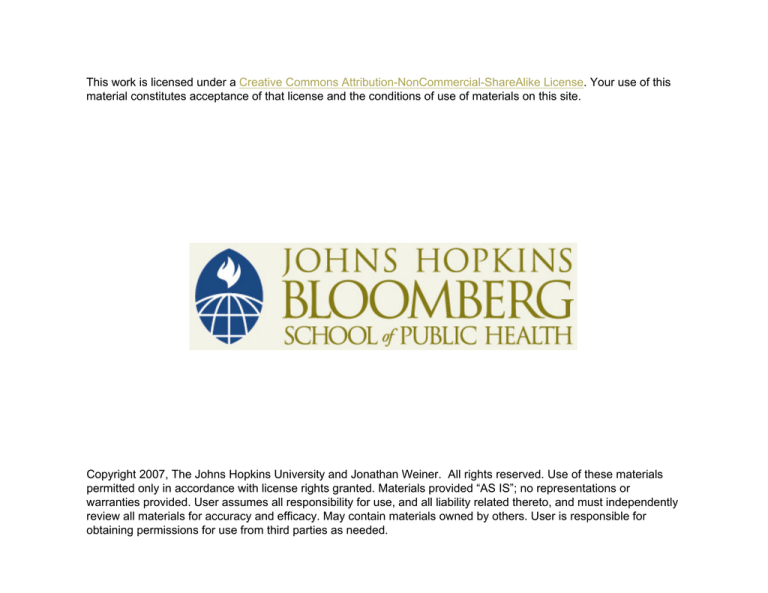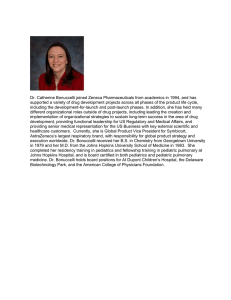
This work is licensed under a Creative Commons Attribution-NonCommercial-ShareAlike License. Your use of this
material constitutes acceptance of that license and the conditions of use of materials on this site.
Copyright 2007, The Johns Hopkins University and Jonathan Weiner. All rights reserved. Use of these materials
permitted only in accordance with license rights granted. Materials provided “AS IS”; no representations or
warranties provided. User assumes all responsibility for use, and all liability related thereto, and must independently
review all materials for accuracy and efficacy. May contain materials owned by others. User is responsible for
obtaining permissions for use from third parties as needed.
Session 6:
Quality, Accountability & P4P In
the Managed Care Context
David Bodycombe, Sc.D. & Jonathan Weiner
The Johns Hopkins University
Copyright 2005, Johns Hopkins University, 2/16/2006
Presentation Goals
• Offer a Managed Care Perspective on the
Themes of Quality and Accountability
• Describe Elements of Pay for Performance
(P4P) Programs
• Review an Exemplary National P4P
Initiative that Focuses on Physician Groups
Copyright 2007, Johns Hopkins University
3
“Quality” Defined
“The degree to which health services for individuals and
populations increase the likelihood of desired health
outcomes and are consistent with current professional
knowledge.”
Institute of Medicine, 1990
“The only definition of quality that matters is the consumer’s.”
W. Edwards Deming
Copyright 2007, Johns Hopkins University
4
What are the Dimensions of Quality?
IOM Goals for the US Healthcare System …
•
•
•
•
•
•
Safe
Effective
Patient-Centered
Timely
Efficient
Equitable
Copyright 2007, Johns Hopkins University
5
The “Value” Perspective on Quality
QUALITY
Economists like to express quality per units of
cost. How much of a valued outcome do you
receive per dollar spent?
This is becoming synonymous with efficiency,
which heretofore had just been about resource
use as a function of cost
About 10% of hospitals delivered high quality at
relatively low cost; arguably have a “culture of
quality”
Goal of some quality-based initiatives is to
identify and describe these high performers so
that others might learn
Copyright 2007, Johns Hopkins University
6
The Theoretical Cost/Quality
“Plateau” Relationship
A
B
Quality
Cost
There are limits to how much quality you can buy
What interest in the optimal level of quality you can get at the lowest cost, i.e., right at inflection point A?
Throw a lot of money at a quality issue and may end of with overuse of “evidenced-based” tests and
procedures?
Copyright 2007, Johns Hopkins University
7
US Public’s Perceptions
Copyright 2007, Johns Hopkins University
8
US Public’s Perception on
Regulation and Managed Care
Copyright 2007, Johns Hopkins University
9
Quality Represents an Important
Dimension of Health Plan
Accountability
A Working Definition of Health Plan
Accountability
The responsibility that the MCO has for the provision of health
care services to its defined population governed by the complex
regulatory, legal, medical and potentially ethical framework that
governs the relationship.
In common usage, an MCO is held accountable for key
provisions of the health benefit contract, for ensuring that its
providers meet reasonable standards of care, for staying within the
government’s regulatory boundaries and for attaining financial and
quality performance targets set by payers/ sponsors.
Copyright 2007, Johns Hopkins University
10
US Public’s Perception -
continued
• Who would you like to regulate managed care?
– Feds
19%
– States
18%
– Independent entity
34%
– No one
16%
Source – Kaiser Family Foundation
Copyright 2007, Johns Hopkins University
11
Some Key Players in the MCO
Quality and Accountability Arena
Involved in Accreditation and Oversight
NCQA URACJCAHO-
National Committee for Quality Assurance
Utilization Review Accreditation Commission
Joint Commission on the Accreditation of
Health Care Organizations
States -
Copyright 2007, Johns Hopkins University
12
Some Key Players in the MCO
Quality and Accountability Arena
QIOs AHRQ IOM FAACT NQF NAIC -
Copyright 2007, Johns Hopkins University
Quality Improvement (aka Peer
Review) Organizations
Agency for Health Care Research &
Quality
Institute of Medicine (NAS)
Foundation for Accountability
National Quality Forum
National Association of Insurance
Commissioners
13
NCQA
• Founded by HMO industry to avoid external
government regulation
• Now employer/ payer perspective is key
• Two main activities:
– Accreditation (heavily internal QI oriented)
– HEDIS (Health Employer Data Information Set)
Performance Monitoring
• Performance Data are Publicly Reported Annually
in Quality Compass
Copyright 2007, Johns Hopkins University
14
“Report Cards” as a Dimension of
Accountability
• HEDIS & HEDIS-like measures very widespread
• Medicaid & Medicare & large employers distribute
widely
• Consumer Survey (e.g. CAHPS)
• Several statewide reports (see Maryland Health
Care Commission - MHCC)
– http://mhcc.maryland.gov/hmo/index.aspx
Evidence of impact decidedly mixed
Copyright 2007, Johns Hopkins University
15
So What Are Plans Doing
Right Now to Address
Quality Issues?
Copyright 2005, Johns Hopkins University, 2/16/2006
The List Includes …
•
•
•
•
•
•
Accreditation Activities
Measurement and Reporting
Quality Improvement Initiatives
Consumer and Community Engagement
Care Management and Disease Management
Pay for Performance
Copyright 2007, Johns Hopkins University
17
Incentivizing Performance:
“Pay for Performance”
(P4P)
Copyright 2005, Johns Hopkins University, 2/16/2006
What Is Pay for Performance?
“The use of incentives to encourage and reinforce
the delivery of evidence-based practices and
health care system transformation that promote
better outcomes as efficiently as possible.”
American Healthways, 2005
Copyright 2007, Johns Hopkins University
19
What Were the Historical Precedents?
• Physicians have had aspects of their performance
under scrutiny for years
– Licensure and certification
– Economic profiling
– Report cards
• Hospitals and health plans have also been subject
to performance review
– Accreditation process
– PSRO/PRO/QIO
– Report cards
Copyright 2007, Johns Hopkins University
20
What Do We Mean By Performance?
Performance is a function of …
•
•
•
•
•
•
Quality
Safety
Access
Satisfaction
Cost
IT Infrastructure
Copyright 2007, Johns Hopkins University
21
Elements of Pay for Performance
• Targeted Entity
• Measures
• Methods
• Incentives
• Reporting
Copyright 2007, Johns Hopkins University
22
Types of Incentive Strategies
• Bonuses (most common form of incentive)
• Tiered Co-Payment
• Increased Reimbursement Rate
• Quality Infrastructure Grants
Copyright 2007, Johns Hopkins University
23
P4P in Action: IHA
To create a business case for quality
improvement through a compelling set of
incentives that will drive breakthrough
improvements in clinical quality and the
patient experience.
• Established under the auspices of the Integrated
Healthcare Association (IHA).
• Collaborate with six large insurers in California (Cigna,
Aetna, Health Net, PacifiCare, Blue Cross, and Blue
Shield).
• Represents 60% of California managed care market.
• Completed first year of P4P program in 2003.
• $50M paid to California physician groups to reward first
year’s performance.
Copyright 2007, Johns Hopkins University
24
P4P in Action: IHA Measures
Targeted Entity
Physician Groups
Measures
• Clinical Quality (Adapted from HEDIS)
– Preventive Care
– Chronic Care
• Patient Experience
– Communication with doctor, timely access, specialty
care, care coordination, and overall care ratings
• Investment In and Adoption of IT
– Point of Care and Population Management
Copyright 2007, Johns Hopkins University
25
P4P In Action: IHA Clinical Quality Measures
• Childhood Immunizations by Age 2 w/ 24 Months
Continuous Enrollment
• Appropriate Treatment for Children with URI
• Cervical Cancer Screening
• Breast Cancer Screening
• Asthma Management
• HbA1c Screening & Control
• LDL Screening & Control <130
• Chlamydia Screening
Copyright 2007, Johns Hopkins University
26
P4P in Action: IHA Methods
• Largely rely on process measures
• Common measures and common data
processing center
• Measures rolled into composite indicators
• Administrative data only, no record review
• Consumer Assessment Survey for patient
experience
• No risk adjustment but metric populations defined
to ensure fairly homogeneous population
• Incorporates auditing step
Copyright 2007, Johns Hopkins University
27
P4P in Action: IHA Incentives
• Each plan sets its’ own incentive structure
• Weighting of measures is suggested
• Some plans set provider group volume thresholds to
participate
• Most pay annually on prior year performance; some
quarterly
• Bonus either allocated based on single measures or
attainment of all
• Maximum PMPM bonus of around $3
• Beginning in 2006 will not be able to pay bonuses to
individual physicians without performance review
• In first year, 2003, $50M paid to California physician
groups to reward first year’s performance
Copyright 2007, Johns Hopkins University
28
P4P In Action: IHA
Reporting
Highly summarized results for provider groups publicly reported on
state of California web site (www.opa.ca.gov).
Issues
• Improvements seen but without controls difficult to assess
whether real and whether worth modest $1,100 in physician
incentives.
• Very difficult to get started and still marked differences in
choice of measures and use of incentives
• Provider group participation only partial
• Associated report cards add a potentially punitive
dimension based upon a simplistic methodology
Copyright 2007, Johns Hopkins University
29
P4P Implications: Some Pros
•
•
•
•
•
•
•
•
Better access to and delivery of preventive services
Potential for reducing waste and inefficiency
Reduced practice variation
Increased use of electronic information systems, including
medical records and disease registries
Move frontline practitioners to more of a population management
approach
Stronger connections with community resources that patients
may call on to enhance chronic care self-management
Improved primary care management of chronic disease with
more practices specializing in chronic care
Better quality and improved outcomes
Copyright 2007, Johns Hopkins University
30
P4P Implications: Some Cons
• Disincentives for physicians to practice in areas with socially
complex patient populations or high levels of health care needs
• Focus on one disease at a time
• Fragmentation of care from management of metrics
• Providers who are on the top have little incentive to improve and
may be on top for unrelated factors
• Widening performance gap between achieving and poor
performers
• Poorer quality of care for un-incentivized conditions
• Higher practice administrative costs to generate P4P metrics
• Very difficult for solo practitioners to participate
Copyright 2007, Johns Hopkins University
31
And What Is the Current State of P4P?
• Depending on who you ask, there are between
100 and 150 P4P programs in the U.S.
• Several high profile initiatives are underway
• The largest P4P “experiment” in the world is
currently underway in the U.K.
• Program growth is way ahead of the ability to
demonstrate sustained savings and improvement
Copyright 2007, Johns Hopkins University
32
Will P4P Work?
• “There is no question that pay for performance will work”
(Thomas Scully, 2003)
• For each health plan to have its own measures, rules,
payment method and payment target creates major
administrative hassles
• Physician acceptance likely determined by the extent to
which health plans commit new funds to reward quality
• Where physicians do not belong to physician organizations,
the numbers of targeted patients in a health plan seeing a
particular physician are too small for reliable measurement
• Evidence for the effectiveness of paying for quality is still
mixed
Copyright 2007, Johns Hopkins University
33
The Last Word
“The problem with pay-for-performance is not that it doesn’t mold behavior.
The problem is that it does mold behavior. You get exactly what you’re
paying for, which might not, in the end, when you’re finally on your
deathbed, be exactly what you wish you’d gotten.”
Don Berwick, 2005
Copyright 2007, Johns Hopkins University
34




